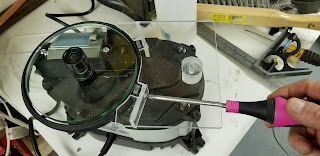Punky As The Blank Was .....
..........I managed to salvage it.
Spalted Maple Bowl
I have this shed full of wood that has been drying for +10 years, all harvested here in Utah.
Last week I visited the wood shed and found a piece of spalted maple that had stunning patterns.
That was the good news, the bad was that this wood was badly punked. It turned like powder.
Determined to salvage this wood I decided to ignore the voids the powdered wood left while turning and just get it shaped and coated.
The blank could not be mounted by its punky bottom (I tried) so I glued a hunk of plywood to the bottom and turned it. I later removed the plywood.
I brushed untold amounts of sanding sealer and finish on the rotating peice until I got the wood stabilized.
Not the fine finish I am used to but I did manage to salvage a beautiful hunk of wood. As Greg, my wood-turning sensei used to say to me "let the wood speak to you" ...... it did!
I can always tell if I did good when my wife (who owns lots of round things) comes into the shop and says; "That bowl isn't going anywhere".
What I Learned About Turning Punky Wood
- It likely that you will not be able to chuck the bowl with a turned foot. You can glue a block on the bottom to use as the foot and then turn it off later. This is the first time I tries this and it worked well.
- You can brush on copious amounts of finish while rotating slowly on the lathe. This stabilizes the wood.
- As always sharp tools help, turn at a fast speed
- Wear a filter mask as there will be lots of dust
 |
| After it was clear that the foot would not hold I glued on a plywood foot for turning. Then it was turned off using the vacuum chuck. |
Coating the surface with finish to stabilize the wood.
Pretty true spin after glue-ing on a block
Turning the bottom with a high angle grind on the tool.
Donate
If this post helped you solve a problem, saved you time or was otherwise useful consider donating. Use the link in the upper right of the site.Donations fund some of the expense of tools and materials for my shop and lab so I can bring you more content like this.
Also let me know if there is other content you would like to see me explore!
Enjoy and Comment,
Don


























































